#rotenone
Explore tagged Tumblr posts
Text

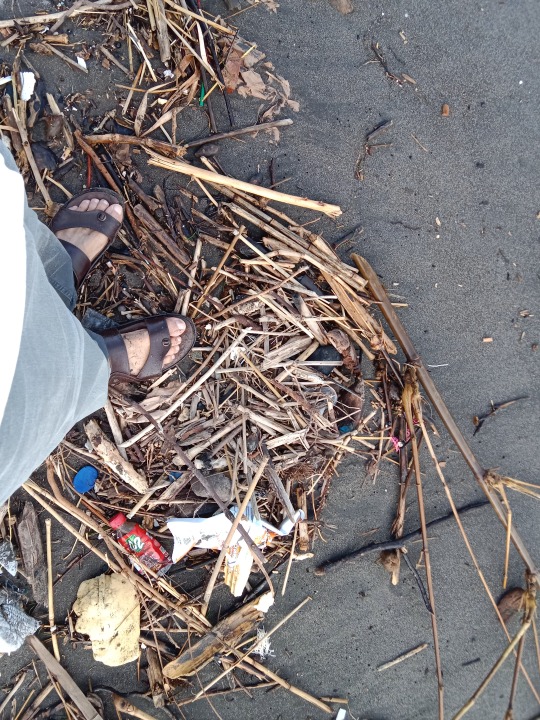
Plants are asocial, especially those that inhabit extreme environments as deserts, seashores and polar regions, and create space for themselves, and hoard scarce resources, by secreting toxic compounds called allelochemicals that essentially sterilize their vicinity of all life.
One such chemical is rotenone, a toxin so powerful it indiscriminately kills insects, plants, fish and mammals, it herbicide, pesticide and piscicide, by interfering with electron transport in their mitochondria.
Molluscan life on the seashore is thus most flourishing and abundant when botany is not allowed to get too close to it, and in nations like India beaten by the giant combers coming in from the open ocean, botany is indeed held at bay by their action, kept at a distance, its toxins not permitted to percolate and seep into the soil and kill off molluscan and other life in the vicinity.
In the enclosed waters that surround many of the islands in the Philippines waves do not have a chance to gain such momentum, and thus plant life approaches quite literally to the edge of the sea in many cases, as can be seen by the huge amount of driftwood piled up here on this shore, which close approach and unleashing of a flood of toxic chemicals would be expected to devastate molluscan communities, and might account for the stark sterility of the sea-sands witnessed here on Dawis Beach, literally no seashells, but for a single specimen - gastropods or bivalves - found here.
Dawis Beach, Near Digos City, January 26, 2024, Mindanao, The Philippines.
#seashore#beach#tropics#sterility#allelochemicals#rotenone#mitochondrial electron transport#toxicity#plant ecology#molluscs#bivalves#gastropods
3 notes
·
View notes
Text
They do not pump protons, so the energy released from the oxidation of NADH is not conserved as ATP but instead is turned into heat (Figure 12.9). (...) The cyanide-resistant oxygen uptake is catalyzed by the alternative oxidase (see Figure 12.9). (...) Multiple rotenone-insensitive dehydrogenases oxidizing NADH or NADPH are found in plant mitochondria (see Figure 12.9).

"Plant Physiology and Development" int'l 6e - Taiz, L., Zeiger, E., Møller, I.M., Murphy, A.
#book quotes#plant physiology and development#nonfiction#textbook#plant cells#rotenone#cyanide#insensitive#resistant#nadh#nadph#electron transfer#oxidation#mitochondria
0 notes
Text
Rotenone-insensitive NAD(P)H dehydrogenases, mostly Ca²+-dependent, are also attached to the outer surface of the inner membrane facing the intermembrane space.
"Plant Physiology and Development" int'l 6e - Taiz, L., Zeiger, E., Møller, I.M., Murphy, A.
#book quote#plant physiology and development#nonfiction#textbook#rotenone#insensitive#nad#nadh#nadph#calcium#cation#dependent#plant cells
0 notes
Text


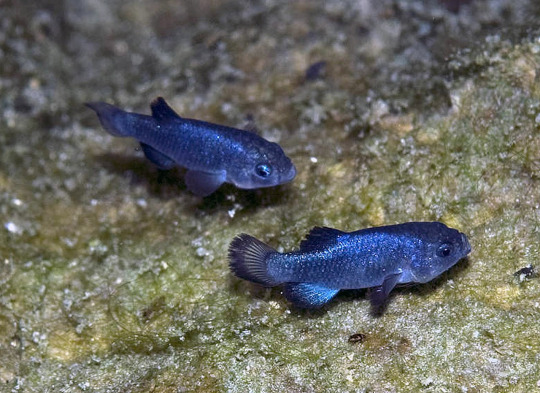



(reposting as I am unable to reblog the original.)
requested by @kodicraft
🔶 Rating: Partially Reliable 🔶
The Devils Hole is home to the endangered Devils Hole Pupfish.
From the National Park Service's page on Devils Hole: 'Devils Hole--a detached unit of Death Valley National Park--is habitat for the only naturally occurring population of the endangered Devils Hole Pupfish (Cyprinodon diabolis).'
The existence of the pupfish does prevent the pumping of groundwater in the area, after a legal battle. I am not sure this would apply to all mining.
From a High Country News article on the pupfish: 'The Cappaert case went all the way to the U.S. Supreme Court, testing the power of the Antiquities Act and the weight of the new Endangered Species Act. In 1976, the High Court affirmed the federal government’s right to maintain water levels sufficient to support the pupfish, even at the expense of water rights held by nearby ranchers.'
The habitat of this fish is incredibly small. However, it is slightly larger than suggested, as the fish swim at least 20m deep; the rock shelf referenced is the only place where the fish feed and spawn in the wild.
From the same National Park Service page: 'Although pupfish have been found as deep as 66 feet (20 m), the fish forage and spawn exclusively on a shallow rock shelf near the surface, feeding on the algae and diatoms found there.'
It is true that multiple conservation attempts have failed. Previous attempts to breed or crossbreed the fish have not been successful.
From a National Park Foundation article on the pupfish: 'Despite past efforts to create a similar artificial platform for the pupfish, as well as attempts to breed Devils Hole pupfish and hybrids in captivity, this small ledge remains the sole spawning and feeding shelf for the fish.'
I have not been able to find any references to 'assassination attempts'. One individual did threaten to pour pesticide into Devil's Hole, but it seems this was never attemped. If anyone can find anything on this, please let me know, but in the mean time I have to say this claim is unsubstantiated.
From a High Country News article on an incident of tresspassing and the pupfish: 'A Pahrump newspaper editor even threatened to throw the pesticide Rotenone into the sunken cave to “make the pupfish a moot point.”'
The fencing was initially installed after two people drowned, not after an assassination attempt. Later, more fencing and security was installed after three men drunkenly tresspassed and killed a pupfish.
From the same National Park Service page: 'Subsequently, the Hole was fenced after two divers drowned in its water.'
From a High Country News article on the incident of tresspassing : 'Since the incident, Devils Hole has become an even more formidable fortress. The Park Service capped its towering fences with additional barbed wire. The public can only view the sunken cave from a distance now, more than 20 feet above it. And inside the fenced viewing area are even more cameras, motion sensors and “No Trespassing” signs.'
There is a breeding program at Ash Meadows Facility, where scientists have attempted to mimic the natural habitat of the pupfish.
From a National Geographic article on the breeding attempts: 'And when they built the Ash Meadows facility, the scientists tried to create a mirror image of Devil’s Hole, which meant bringing in water, substrate, and algae from the natural environment.'
It is possible that a different research/breeding facility is being referred to, but the Ash Meadows Facility does not seem to have a secret location. In fact, the facility is open to visitors, according to their website.
I wont attempt to fact check whether the cave is haunted, but I can confirm that at least two people drowned and were not recovered from Devils Hole. Whilst the cave is not truly bottomless, the bottom has not yet been found.
From an SFGATE article on Devils Hole: 'When the bottom of Devils Hole is one day found, the skeletons of two brothers-in-law may finally be recovered, fathoms below the frolicking pupfish.'
The breeding program has been more successful in recent years. This may be due to the discovery that diving beetles were eating the eggs and larvae, and the beetle population in the artificial environment being controlled. (This fact was not included in the original post, but I thought it was cool.)
From a National Geographic article on the breeding attempts: 'As Feuerbacher watched the infrared footage, which can visualize objects in the dark, a tiny pupfish larva smaller than a peppercorn flitted into the camera’s frame. This was big news. When a population gets as low as that of the pupfish, every animal—wild or captive, larva or adult—is critical to the species’ survival.
“I was pretty excited to see there was reproduction going on in the tank, and I just watched it for a little bit,” says Feuerbacher, a fish biologist with the U.S. Fish and Wildlife Service. “Then I saw a beetle swim past.”
It began circling the fish, and closing in.
“Then it just dove in and basically tore the fish in half right while I was watching,” says Feuerbacher.
[...]
During the first beetle collection, facility manager Jennifer Gumm says they caught 500 beetles in three hours. And on the very next pupfish egg collection, which is done by leaving out pieces of carpet that the fish like to lay their eggs on, the team retrieved close to 40 pupfish eggs.
Before this, they had been lucky to find four or five pupfish eggs during a refuge collection. Usually, it was zero.'
3K notes
·
View notes
Photo


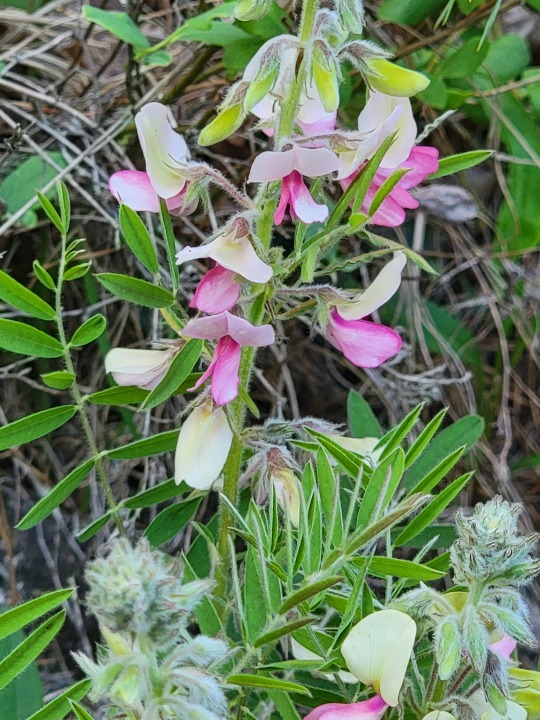
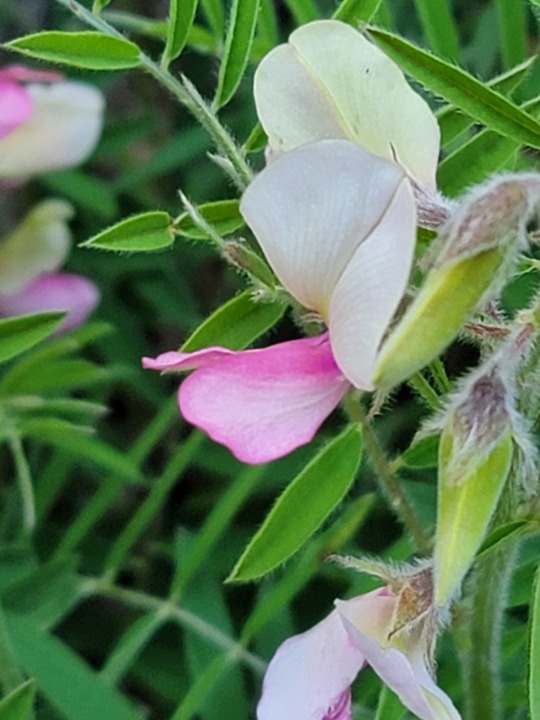
Virginia Goats Rue,
Tephrosia virginiana
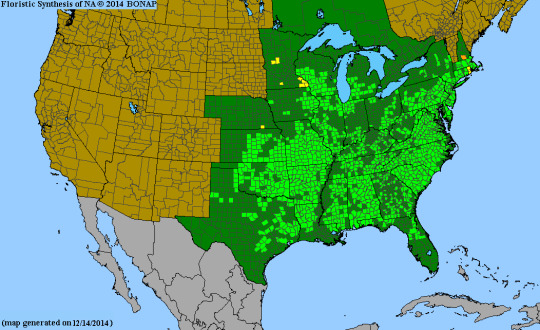
Whenever I see this plant I think acidic nutrient poor soils, ericaceous.
It prefers acidic weathering sand, well drained, in full sun, and often is associated with heavily mycorrhizal dependent environments despite not associating with mycorrhizae. It’s extremely good at nitrogen fixation and cannot take being shaded out. Sandy oak savanna, pine barrens, riolitic gravel barrens, dry prairie with an associated circum acidic ph are ideal locations for this species. Here, at RRG, we see it on a burn ridge, specifically in MG FE rich acidic sandstone in what is classified as an ericaceous heath belt. It is not a forbe despite it’s looks but has a woody basal crown and a very stout woody tap root that branches scarcely into tenuous fibrous roots with root nodules for the nitrogen fixing bacterial units. Some claim that this physiological trait is a caudex or a caudiform structure, though it’s more knobby and less of a thickened mass/base that hasn’t been fully investigated for water storage, instead I think that it’s maybe more likely to produce herbaceous epicormic shoots as a reaction to fire and may more likely be a lignotuber(post fire regenerative woody knobby base) instead of a caudex; either way, this woody habit makes this species a sub shrub and not a forbe. Animals are not likely to graze/ browse on this legume due to slight toxicity; with this said, the rotenone compound is a known icthyotoxic chemical (lethal to fish if made into root powder and used.) While no longer used for fishing due to knowledge of bio-accumulation of toxins, it is being researched for invasive species control. The species reminds me of partridge pea in it’s ground bird dispersed seeds, while we have a true Faboideae sect. species with banner and keel morphology, you’ll notice that it has an exposed/ keel and wing form allowing easy access and buzz pollination more often than most papillionaceous flowers. (senna and partridge peas are primarily buzz pollinated and are in sect. Caesalpinioideae (subfamily of fabaceae)). I see more bumble bees and wasps on this species than any other forbe this time of year ( Late May).
Most Tephrosia are coastal plains species with only one other “wide spread” species (T. spicata)
Though T. onobrychoides does make it in-land due to Oklahoma short grass prairie matrix.
42 notes
·
View notes
Text
Ăn củ đậu khi mang thai 3 tháng đầu được không?
Mẹ có bầu 3 tháng đầu ăn củ đậu được không? 3 tháng đầu thai kỳ là khoảng thời gian cơ thể mẹ rất ‘nhạy cảm’ nên việc lựa chọn thực phẩm để bổ sung vào thực đơn dinh dưỡng cũng trở nên khắt khe hơn. Tuy rằng đây là thực phẩm lành tính nhưng khi sử dụng cũng cần lưu ý nhiều vấn đề quan trọng. Cụ thể hơn, mẹ hãy tìm hiểu ngay trong bài viết dưới đây.
Ăn củ đậu khi mang thai 3 tháng đầu được không?
Khi mang thai lần đầu, nhiều phụ nữ thường thắc mắc “bầu 3 tháng đầu ăn củ đậu được không?”. Và may mắn thay, đây là một loại củ giàu dưỡng chất và lành tính, cho nên mẹ bầu hoàn toàn có thể ăn được. Thậm chí, thành phần dinh dưỡng của củ đậu còn có chứa nhiều dưỡng chất có lợi cho sức khỏe thai phụ và quá trình hình thành, phát triển toàn diện của thai nhi như canxi, DHA, vitamin C, protein, chất xơ,… Thai phụ có thể đưa củ đậu vào thực đơn hàng ngày mang lại nhiều lợi ích cho sức khỏe và sắc đẹp của chị em.
Giảm căng thẳng, stress
Vitamin B6 không chỉ có tác dụng làm giảm nôn nghén cho bà bầu mà còn tham gia vào quá trình sản xuất hồng cầu, bổ sung năng lượng cho cơ thể. Mẹ bầu 3 tháng đầu thường xuyên ăn củ đậu cũng có tác dụng bổ thần kinh, nâng cao chất lượng giấc ngủ, giảm stress rất hiệu quả.
Giảm nôn nghén
Trong 100g củ đậu có 0.042mg vitamin B6 có tác dụng làm giảm buồn nôn, bị nôn, cải thiện tình trạng ốm nghén hiệu quả. Bà bầu 3 tháng đầu thường xuyên đưa củ đậu vào thực đơn cho bà bầu kén ăn sẽ giúp giảm nôn nghén, bổ sung đa dạng dưỡng chất, nâng cao sức khỏe thai kỳ.
Xem thêm: tại sao uống sắt bị buồn nôn
Tăng sức đề kháng và khả năng miễn dịch
Trong 100g củ đậu có chứa 20.2mg vitamin C – một chất chống oxy hóa mạnh mẽ, có tác dụng tăng sức đề kháng hiệu quả. Ngoài ra, Vitamin C còn giúp sắt hấp thụ dễ dàng hơn, ngăn ngừa thiếu máu thiếu sắt và làm tăng khả năng miễn dịch cho mẹ bầu.
Tăng khả năng tiêu hóa
Trong củ đậu có chứa đến 90% nước và 4.9% chất xơ có tác dụng tăng cường trao đổi chất, tăng khả năng tiêu hóa, nhuận tràng. Bà bầu thường xuyên đưa củ đậu vào thực đơn hàng ngày sẽ giúp ngăn ngừa và cải thiện tình trạng táo bón rất phổ biến khi mang thai.
Xem thêm: Bầu quên uống canxi 1 ngày có sao không
Làm đẹp da
Vitamin E, C và nước có trong củ đậu giúp làn da của mẹ bầu luôn mịn màng, tươi sáng nhờ khả năng cung cấp nước và giữ ẩm cho da, tái tạo và nuôi dưỡng tế bào da, giảm tác hại của tai UV, làm mờ thâm nám, chống nhăn và chảy xệ, tiêu diệt những gốc tự do gây hại cho da, làm chậm quá trình lão hóa da,…
Giúp xương, răng chắc khỏe
Canxi và phốt pho có trong củ đậu là thành phần chính trong cấu tạo của xương, răng. Bà bầu thường xuyên ăn củ đậu không chỉ giúp xương, răng của bản thân chắc khỏe, giảm nguy cơ loãng xương và các bệnh nha khoa. Đồng thời còn có tác dụng hỗ trợ quá trình hình thành và phát triển xương của thai nhi, giúp trẻ sinh ra cao lớn, khỏe mạnh hơn.
Xem thêm: sắt và canxi uống cách nhau bao lâu
Giảm nguy cơ mắc chứng tiểu đường thai kỳ
Tổng lượng đường trong củ đậu là 1.8%, an toàn với mẹ bầu bị tiểu đường thai kỳ. Hàm lượng chất xơ cao còn giúp bà bầu ổn định đường huyết, giảm nguy cơ mắc tiểu đường ở những giai đoạn sau của thai kỳ.
Lời khuyên an toàn cho mẹ bầu ăn củ đậu trong thai kỳ
Để đảm bảo an toàn khi ăn củ đậu trong thai kỳ, mẹ bầu cần lưu ý một số vấn đề sau:
Không ăn quá nhiều: Theo các chuyên gia dinh dưỡng, mỗi ngày mẹ bầu chỉ nên ăn khoảng 200g củ đậu để tránh bổ sung quá nhiều nước làm mất cảm giác thèm ăn, đói, dễ dẫn đến bỏ bữa và không bổ sung đủ dinh dưỡng cho cơ thể. Không nên ăn củ đậu vào buổi tối: Bà bầu ăn củ đậu vào buổi tối dễ bị tiểu đêm, chướng bụng, đầy hơi, khó tiêu,… ảnh hưởng đến chất lượng giấc ngủ. Tuyệt đối không ăn lá và hạt củ đậu: Trong lá và hạt cây củ đậu có chứa rotenon và tephrosin có thể gây ngộ độc, khiến bà bầu bị đau bụng, tiêu chảy trong vòng 5 – 40 phút. Sau khi ăn phải hạt hay lá củ đậu mà thấy có hiện tượng bất thường, bà bầu phải đến cơ sở y tế ngay lập tức để được bác sĩ kiểm tra và điều trị kịp thời. Củ đậu không thể là thức ăn chính cho bà bầu: Mặc dù củ đậu rất giàu vitamin và khoáng chất nhưng lại không chứa chất béo và chỉ có rất ít đạm. Do đó bà bầu không nên sử dụng củ đậu như thực phẩm chính trong các bữa ăn hàng ngày để tránh bị thiếu hụt dinh dưỡng làm ảnh hưởng đến sức khỏe bà bầu và quá trình hình thành, phát triển của thai nhi.
Ngoài các chú ý trên, mẹ bầu còn cần ăn đa dạng các loại thực phẩm nhằm giúp cơ thể được bổ sung đa dạng các nhóm dưỡng chất. Bên cạnh đó, đừng quên kết hợp bổ sung sắt canxi DHA cho mẹ sau sinh bằng những sản phẩm uy tín để có luôn đủ chất và khỏe mạnh!
Khi mang thai các mẹ thường gặp nhiều vấn đề sức khỏe nên cần chú ý hơn trong cách ăn uống. Đối với thắc mắc bà bầu 3 tháng đầu ăn củ đậu được không thì câu trả lời là mẹ hoàn toàn có thể bổ sung loại củ này vào bữa ăn nhé. Hy vọng những gợi ý trên sẽ giúp các mẹ có thêm ý tưởng nấu ăn ngon bổ dưỡng hơn.
0 notes
Text
Anti-Tick Dog Shampoo: Protecting Your Furry Friend from Ticks and Tick-Borne Diseases

Say Goodbye to Ticks: The Benefits of Anti-Tick Dog Shampoo
Anti-Tick Dog Shampoo: Protecting Your Furry Friend from Ticks and Tick-Borne Diseases
As a dog owner, keeping your furry friend safe from ticks and other external parasites is crucial. Ticks can transmit diseases like Lyme disease, Rocky Mountain spotted fever, and ehrlichiosis, which can be life-threatening. One effective way to protect your dog from ticks is by using an anti-tick dog shampoo.
In this article, we'll delve into the world of anti-tick shampoo for dogs their benefits, and how to use them effectively. We'll also introduce you to Puppiezo Anti-Tick Dog Shampoo (500 ml), a natural and gentle solution for your dog's tick problems.
What is Anti-Tick Dog Shampoo?
Anti-Tick Dog Shampoo is a specialized shampoo designed to kill and repel ticks on your dog's coat. These shampoos typically contain ingredients like pyrethrin, rotenone, and permethrin, which are toxic to ticks. When used regularly, anti-tick dog shampoo can help prevent tick infestations and reduce the risk of tick-borne diseases.

Benefits of Using Anti-Tick Dog Shampoo
Using anti-tick dog shampoo for dog offers several benefits, including:
Effective tick control: Anti-tick dog shampoo kills and repels ticks, reducing the risk of tick-borne diseases.
Convenient: Anti-tick dog shampoo is easy to use and can be incorporated into your dog's regular grooming routine.
Reduces tick-related stress: By controlling ticks, anti-tick dog shampoo can reduce stress and anxiety caused by tick infestations.
Soothes the skin: Many anti-tick dog shampoos, like Puppiezo Anti-Tick Dog Shampoo, contain natural ingredients that soothe and moisturize the skin.

Puppiezo Anti-Tick Dog Shampoo (500 ml)
Puppiezo Anti-Tick Dog Shampoo is a natural and gentle solution for your dog's tick problems. This shampoo is:
Gentle on pets: Puppiezo Anti-Tick Dog Shampoo is gentle on your pet's skin, making it suitable for dogs of all ages and breeds.
Harsh on ticks: The shampoo effectively kills and repels ticks, reducing the risk of tick-borne diseases.
Natural ingredients: Puppiezo Anti-Tick Dog Shampoo contains natural ingredients that soothe and moisturize the skin.
pH balanced: The shampoo is pH balanced, ensuring it doesn't irritate your dog's skin.
Deep cleanses: Puppiezo Anti-Tick Dog Shampoo deep cleanses your dog's coat, removing dirt and ticks.
How to Use Puppiezo Anti-Tick Dog Shampoo
Using Puppiezo Anti-Tick Dog Shampoo is easy:
Shake well before using: Before applying the shampoo, shake the bottle well to ensure the ingredients are mixed.
Wet the coat thoroughly: Wet your dog's coat thoroughly before applying the shampoo.
Apply shampoo: Apply the shampoo, working from head to tail.
Rinse away: Rinse the shampoo off your dog's coat, ensuring all traces are removed.
Apply conditioner: After shampooing, apply a conditioner to moisturize and soothe the skin.
Rinse away conditioner: Rinse the conditioner off your dog's coat, ensuring all traces are removed.
Dry your dog: Use an absorbent towel to soak away all moisture, ensuring your dog's coat is dry and comfortable.

Precautions and Side Effects
While Puppiezo Anti-Tick Dog Shampoo is generally safe, there are some precautions and side effects to consider:
Skin irritation: Some dogs may experience skin irritation or allergic reactions. If this occurs, discontinue use and consult your veterinarian.
Overuse: Avoid overusing anti-tick shampoo, which can lead to skin irritation and other issues.
Conclusion
Puppiezo Anti-Tick Dog Shampoo (500 ml) is a natural and gentle solution for your dog's tick problems and the best anti-tick shampoo for dogs. By using this shampoo regularly, you can keep your furry friend safe from ticks and tick-borne diseases. Remember always to follow the instructions and take necessary precautions to avoid side effects. With Puppiezo Anti-Tick Dog Shampoo, you can enjoy a tick-free life with your dog and puppies.
#dog shampoo#dog shampoo price#dog shampoo for puppies#best anti tick shampoo for dogs#anti tick shampoo for dogs#anti tick shampoo dogs#anti tick dog shampoo#puppiezo anti-tick dog shampoo#puppiezo
0 notes
Link
0 notes
Quote
The present invention relates to an agent for use in selectively killing one or more senescent cells, wherein said agent is selected from the following: a cardiac glycoside or alglycone, a focal adhesion kinase (FAK) inhibitor, an HMG-CoA reductase inhibitor, JFD00244, Cyclosporine, Tyrphostin AG879, Cantharidin, Diphenyleneiodonium chloride, Rottlerin, 2,3-Dimethoxy-1,4-naphthoquinone, LY-367,265, Rotenone, Idarubicin, Dequalintum chloride, Vincristine, Nitazoxanide, Nitrofurazone, Temsirolimus, Eltrombopag, Adapalene, Azacyclonol, Enoxacin and Raltegravir, and pharmaceutically acceptable salts thereof. Another aspect relates to compounds for use in treating or preventing a senescence- associated disease or disorder, and methods relating thereto.
WO2018215795A3 - Senolytic compounds - Google Patents
0 notes
Text
What Is Eco Pest Control And How Does It Work?
Are you tired of using traditional pest control methods that harm the environment and potentially harm your family and pets? Then it's time to consider eco pest control. In this article, we'll explore what eco pest control is and how it works to keep pests at bay without harming the environment.
Table of Contents
Introduction: What is Eco Pest Control?
Eco pest control is a natural alternative to traditional pest control methods that use chemicals that can harm the environment, wildlife, and humans. Eco pest control uses natural methods to control pests, such as essential oils, botanical insecticides, natural predators, and biological pest control.
The Advantages of Eco Pest Control
Eco pest control offers several advantages over traditional pest control methods. Some of the benefits of eco pest control include:
How Does Eco Pest Control Work?
Eco pest control works by using natural methods to control pests. These methods include natural predators, essential oils, botanical insecticides, and biological pest control.
The Types of Eco Pest Control Methods
Natural Predators
One of the most effective ways to control pests naturally is by using natural predators. Natural predators are animals that eat pests. For example, ladybugs eat aphids, and praying mantises eat caterpillars. By introducing natural predators into your garden or home, you can control pests without harming the environment.
Essential Oils
Essential oils are another natural pest control method. Many essential oils have insecticidal properties and can be used to repel or kill pests. Some of the essential oils commonly used for pest control include peppermint, eucalyptus, and lavender.
Botanical Insecticides
Botanical insecticides are derived from plants and are a natural alternative to traditional insecticides. They are effective at controlling pests and are safe for the environment. Some of the most commonly used botanical insecticides include neem oil, pyrethrum, and rotenone.
Biological Pest Control
Biological pest control uses living organisms to control pests. For example, Bacillus thuringiensis (Bt) is a bacterium that is toxic to certain types of insects, including caterpillars and mosquitoes. It is a safe and effective way to control pests without harming the environment.
Preventative Measures
Preventative measures are also an essential part of eco pest control. These measures include keeping your home or garden clean and free of debris, sealing up any cracks or holes, and using pest-resistant plants.
DIY Eco Pest Control Solutions
There are many DIY eco pest control solutions you can use to control pests naturally. Some of these solutions include using vinegar or citrus peels to repel ants, planting marigolds to repel mosquitoes.
0 notes
Text
ɪyttaɪsgæəəætʃɑlmltəəo
Pronounced: iyttaisgauhuhatshahlmltuhuho.
Pantheon of: irrational motive, power, ethical motive, inactiveness.
Entities
Bwndiksdoæzsnnɪəæɪʊɪ
Pronounced: bwndiksdoazsnniuhaiooi Irrational Motive: compulsion. Power: effectiveness. Ethical Motive: hedonism. Inactiveness: indolence. Prophecies: ring containment, final examination, babel. Relations: bztərhdættnttætbrdʒðk (depilatory), æmaɪəəbɛəətʃrelidlmbʃə (columniation), ðzəʌtntzsəətktaɪyərnk (sodium).
Bztərhdættnttætbrdʒðk
Pronounced: bztuhrhdattnttatbrjthk Irrational Motive: compulsion. Power: repellent. Ethical Motive: hedonism. Inactiveness: languor. Legends: electric shock, stylization. Prophecies: washup, downspin, electronic reconnaissance, thaumatolatry, assumption. Relations: dwnnkbədlɪaɪzʌsrkɪɪfi (definite article).
Dwnnkbədlɪaɪzʌsrkɪɪfi
Pronounced: dwnnkbuhdliaizusrkiifi Irrational Motive: compulsion. Power: valence. Ethical Motive: inner light. Inactiveness: passivity. Legends: takedown, plunk, dispensation, indemnification, rattle. Prophecies: submersion, volumetric analysis. Relations: ðmtlniɪaʊʃɪbkəununriʃ (molybdenum), ɪdnmuðərtənɪbɪwətaɪnɪ (flight feather).
Smtlkəiɑsɛmθnʌrsŋsnɑ
Pronounced: smtlkuhiahsaymthnursngsnah Irrational Motive: compulsion. Power: interest. Ethical Motive: hedonism. Inactiveness: restfulness. Legends: representation, parlay, benefit of clergy, three-ring circus. Relations: ɪdnmuðərtənɪbɪwətaɪnɪ (direct loan), bwndiksdoæzsnnɪəæɪʊɪ (indian red), bztərhdættnttætbrdʒðk (ruby).
Yznɛdʒɛðəmsrənwoəmsnm
Pronounced: yznayjaythuhmsruhnwouhmsnm Irrational Motive: compulsion. Power: puissance. Ethical Motive: hedonism. Inactiveness: languor. Legends: march, ghost dance. Prophecies: athletics, multimedia, osteoclasis, cocktail party, hurl. Relations: dwnnkbədlɪaɪzʌsrkɪɪfi (alnico), ɪdnmuðərtənɪbɪwətaɪnɪ (levant), ðzəʌtntzsəətktaɪyərnk (printer's ink), æmaɪəəbɛəətʃrelidlmbʃə (distilled water).
Zdnŋkəiiɪihrtɛuəʃəbɛ
Pronounced: zdnngkuhiiiihrtayuuhshuhbay Irrational Motive: mania. Power: irresistibility. Ethical Motive: conscience. Inactiveness: passivity. Legends: upturn, resolution, resumption. Prophecies: war, flip, scat, backhand drive. Relations: ðmtlniɪaʊʃɪbkəununriʃ (gum).
Æmaɪəəbɛəətʃrelidlmbʃə
Pronounced: amaiuhuhbayuhuhtshrelidlmbshuh Irrational Motive: irrational impulse. Power: sway. Ethical Motive: conscience. Inactiveness: languor. Legends: disposal, special, harvest, pitch. Prophecies: custom, packing, debarkation. Relations: zdnŋkəiiɪihrtɛuəʃəbɛ (allowance).
Ðmtlniɪaʊʃɪbkəununriʃ
Pronounced: thmtlniiowshibkuhununrish Irrational Motive: mania. Power: irresistibility. Ethical Motive: conscience. Inactiveness: restfulness. Relations: yznɛdʒɛðəmsrənwoəmsnm (cadmium orange).
Ðzəʌtntzsəətktaɪyərnk
Pronounced: thzuhutntzsuhuhtktaiyuhrnk Irrational Motive: compulsion. Power: irresistibility. Ethical Motive: hedonism. Inactiveness: languor. Legends: social event, piloting, descent, perfect game, coloratura. Prophecies: longways, kentucky derby, maneuver. Relations: bztərhdættnttætbrdʒðk (adnoun), dwnnkbədlɪaɪzʌsrkɪɪfi (renin), yznɛdʒɛðəmsrənwoəmsnm (focal distance), smtlkəiɑsɛmθnʌrsŋsnɑ (riesling).
Ɪdnmuðərtənɪbɪwətaɪnɪ
Pronounced: idnmuthuhrtuhnibiwuhtaini Irrational Motive: irrational impulse. Power: free will. Ethical Motive: hedonism. Inactiveness: passivity. Legends: roping. Prophecies: fraud in the inducement, dissidence. Relations: æmaɪəəbɛəətʃrelidlmbʃə (cordovan), ðmtlniɪaʊʃɪbkəununriʃ (rotenone), bwndiksdoæzsnnɪəæɪʊɪ (essential amino acid), dwnnkbədlɪaɪzʌsrkɪɪfi (pittance).
0 notes
Text

Cải sinh việc lưu thông huyết Củ đậu tốt ích rất hay trong những việc giữ lại mức độ khỏe khoắn của khối hệ thống tuần trả dựa vào lượng đồng và Fe đã có sẵn bên phía trong. Tình huống nếu như ko với cụm bộ phận này khung người có khả năng sẽ bị thiếu thốn huyết và buổi giao lưu của các đơn vị không giống cũng trở thành ảnh hưởng tác động tại thiếu thốn huyết. Hình họa minh họa. (Mối cung cấp hình họa: Mạng internet) Xúc tiến hấp thụ chất lượng tốt Vào tiêu hóa, Inulin vào vai trò vô cùng cần thiết, nhằm mục đích tăng nhanh sức khỏe mang lại đường tiêu hóa. Hóa học này có công dụng trị lành vớ cả những yếu tố nhưng mà tiêu hóa bắt gặp cần, thông thường với vào rau quả, hoa quả trái cây. Vào củ đậu, có một dung lượng vô cùng rộng lớn Inulin cùng theo với hóa học xơ, góp xúc tiến quy trình hấp thụ, lưu lưu giữ dưỡng chất nhiều rộng trên đường tiêu hóa. Củ đậu tư vấn chất lượng tốt mang lại tiêu hóa, góp giải nhiệt độ nhanh chóng, giải độc rượu, nhuận trường tại với biết bao hóa học xơ, tránh tăng tiết axit bao tử. Góp xương và răng mạnh bạo Một trong các những tính năng của củ đậu được không ít người biết tới là góp xương và răng chắc chắn khỏe khoắn. Dung lượng photpho và kali với vào củ đậu tiếp tục góp giữ lại sự trở nên tân tiến của xương và răng. Vì vậy, nhằm xương và răng trở nên tân tiến mạnh bạo tầm thường thì chúng ta có thể bổ sung cập nhật củ đậu thông thường xuyên vào menu đủ dinh dưỡng thường ngày của bản thân mình. Tăng nhanh hệ miễn kháng Sở hữu một lượng Vi-Ta-Min C vô cùng rộng lớn được nhìn thấy vào củ đậu, 100 gram củ đậu cung ứng khoảng tầm 40% axit ascobic hằng ngày của người ta. Vi-Ta-Min C là một trong phần chính yếu vào khối hệ thống miễn kháng của người ta vì như thế nó kích ứng cụm tế bào bạch huyết cầu, là tuyến chống thủ chủ yếu đi đầu của khung người ngăn chặn bị bệnh. Kungfu cùng với cụm căn bệnh tại vi trùng, virus, nấm hoặc mầm căn bệnh được thực hiện nay bằng phương pháp bổ sung cập nhật Vi-Ta-Min C vào khung người. Ngăn chặn ung thư Dung lượng hóa học chống lão hóa quá cao được nhìn thấy vào củ đậu. Hóa học này góp ngăn chặn cụm nguyên gốc tự tại, phòng tránh sự tạo hình cụm tế bào ung thư. Những để ý nên biết Khi ăn củ đậu Củ đậu mang mặc dù rất dễ ăn, mặc dù ăn sinh sống hoặc chín luôn được tuy nhiên bạn không nên ăn nhiều, vì như thế lượng nước vào củ sắn nhiều rất có thể thực hiện bao tử dãn ra, vấn đề này thực hiện mang lại bao tử hấp thụ đồ ăn nhanh chóng rộng thực hiện tổ ấm dễ dàng cảm nhận thấy đói. Nhất là cùng với những bạn đang tránh cân nặng thì nên làm ăn tại mức vừa cần, ko dùng để làm đồ ăn thức uống chủ yếu nhằm rời tạo nên cụm tính năng ko chất lượng tốt mang lại mức độ khỏe khoắn như mệt rũ rời, uể oải, thiếu thốn năng lực. Lá và phân tử của củ đậu rất có thể dùng để làm thuốc dạng bôi ngoại trừ domain authority, tuy vậy vô cùng ko được ăn vì như thế với chứa chấp bộ phận hóa học tephrosin và rotenon, hóa học này nếu như tiêu thụ vào khung người rất có thể khiến ngộ độc, cho dù bị nhức bụng kinh hoàng, toàn thân bị teo rung, loàn nhịp tim, tụt áp suất máu, suy thở. #lợi #ích #bất #ngờ #tới #kể từ #củ #đậu nguồn gốc tin tức " news.google.com
0 notes
Text
this is like when the nest (1988) didn't want to namedrop rotenone so they called it something like rotenene?? thats not a drug you fakers
ive said it before but being in microbiology ruins the fake science in movies bc im too aware of what's realistic and what isn't.

they stood in front of this chalk board for not even 5 seconds and i was like. is that heme. did they put aromatic sidechains on a heme.
14 notes
·
View notes
Text
Ethanol extract of Epipremnum aureum leaves attenuate intranigral-rotenone induced Parkinson’s disease in rats
Ethanol extract of Epipremnum aureum leaves attenuate intranigral-rotenone induced Parkinson’s disease in rats JPPRes

Image: pixabay.com Article published in Journal of Pharmacy & Pharmacognosy Research 8(3): 225-236, 2020. Suraj Sood1, Manish Kumar1,2, Nitin Bansal1*
1Department of Pharmacology, ASBASJSM College of Pharmacy, Bela (Ropar), Punjab-140111, India.2I. K. Gujral Punjab Technical University, Kapurthala, Punjab-144603, India.*E-mail: [email protected]
Abstract
Context: Parkinson’s…
View On WordPress
0 notes
Text
Truly my favorite part of this field is resuspending dangerous chemicals, and despite following all precaution, the dumb idiot anxiety-riddled part of my brain going "well, what if you're inhaling this anyways?"
Like thank you! Yes this is what I need right now!
#don't mind me#casually googling rotenone poisoning as i'm making aliquots#yes this is a totally normal and not at all weird thing to do#anyways i'm still alive and not experiencing ashpyxiation so like#i'm probably fine
0 notes